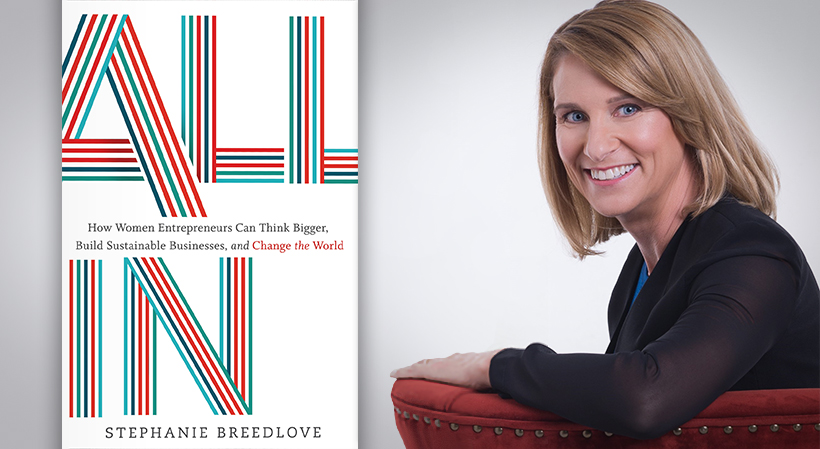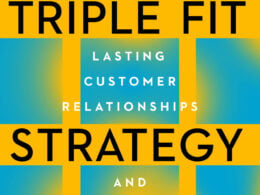“All In” is a valuable tool for crafting your professional and personal roadmap to entrepreneurial success. It offers research-based information, case studies and transparent insights from my 20-year journey, from startup to scale to a $55 million acquisition.
It delivers business strategies, life strategies and recommended next steps at every stage of the journey and is useful for anyone building a business. Yet it is written from a woman’s perspective, recognizing that the advancement of women in entrepreneurship requires transparent discussion of barriers, what the journey truly looks like and smart efforts for creating the economic and societal change we seek.
When I took the leap into entrepreneurship, I had a lot of camaraderie, as there were (and still are) a lot of women starting and running small businesses. As my company scaled to over $10 million in revenue, I lost the camaraderie and felt very alone. I’ve learned that there are only 14,000 businesses owned by women with over $10 million in revenue in the U.S., and businesses owned by men are 3.5 times more likely to cross the $1 million revenue mark. My story is not extraordinary, and there should be many, many more women building businesses of scale.
“All In” is one of the few books written for women entrepreneurs by a woman entrepreneur, and it provides the information and guidance needed to make tough decisions where there are no easy answers. Go all in and take your business everywhere it is meant to go!
The following excerpt is provided exclusively for StartupNation from “All In: How Women Entrepreneurs Can Think Bigger, Build Sustainable Businesses and Change the World” Copyright © 2017 by Stephanie Breedlove, Greenleaf Book Group Press.
“Women own 35 percent of U.S. businesses but generate only 3.8 percent of revenue and employ only 6.2 percent of workers.”
—American Express OPEN
The wakeup call
One day, I received a call from a competitor. This was, of course, highly unusual. How many times has a competitor called you about your business? I closed my office door, something I rarely did. Thoughts of uncomfortable confrontation flashed into my mind. I took a breath, wiped the sweat from my hands, and picked up the phone. After a few minutes of small talk about the latest industry conference, she said, “Stephanie, I’ve been paying attention to your company. You work hard and offer a quality product and service. I’m guessing you have annual revenue between $350,000 and $450,000 and somewhere around one thousand clients. We are impressed with your progress and are interested in opening a dialogue to acquire your company.” She was spot on. We were on target to close the year with $440,000 in revenue and roughly 1,200 active clients. How did she know?
Never in a million years would I have imagined this conversation. This was so far from our goals, strategies, focus and daily reality. I was struggling to comprehend what she was saying. I listened intently, as it is valuable to entertain all ideas. I also listened because I was curious. I expressed how honored I was that we were the focus of such a strategic idea, thanked her for her time, and let her know I would give it serious consideration.
I hung up the phone and stared at the wall for a moment, thinking, What the !%#$! We were just a small business, putting one foot in front of the other, in a tiny office that smelled of mold, and had one of our employees sharing her workspace with a wall of office supplies. We were not acquisition material. Then it hit me like a ton of bricks—a jolt so valuable that I still carry a few of those bricks with me as a reminder of the importance of thinking big. She was afraid of our growing size, our quality, our impact, our leadership, our potential and our momentum. She could see that we were becoming big and was willing to entertain a risky move to acquire us, just to take us out. WOW. She saw it. We didn’t. Our heads were down. We prided ourselves on our humble ability to be heads down, but our heads were in the sand when it came to truly thinking big. Her image of us was not the image we’d painted for ourselves. That offer was a wakeup call. It was thought provoking, a confidence boost and a gift.
Related: Don’t Pitch Your Business, Pitch Yourself [Book Excerpt]
I suppose it would have been easy to engage in a discussion about selling the company, but instead I saw a different opportunity. Grand scale opportunity was waiting to be seized if we engaged in thinking bigger, if we let ourselves dream without the pressure that it may not become reality, if we allowed ourselves to view our potential as great, and if we believed in endless opportunities. I realized this type of thinking wasn’t misplaced, egotistical confidence, but rather a necessary ingredient for going where we were capable of going and becoming who we were capable of being. Without it, grand-scale opportunity could not be seized.
Would we be successful and fulfilled without seizing grand-scale opportunity? Absolutely. It’s not black and white, do or die. It’s just that the line between seizing this level of opportunity or not is very thin. Could it be that the difference in successful impact and grand-scale impact is not only about good effort but also about the ability to think big? We weren’t thinking about grand-scale impact, but if the opportunity was there, why weren’t we? That call made me think bigger. We ended up saying “no thank you” to acquisition talks, because an important next step had been ignited: add thinking bigger to our goals and aspirations. Not just for the quarter or the year, but for the decade. In doing so, we grew to be two to three times the size of that competitor.
The price of thinking small
Although women-owned businesses have grown in number, the vast majority start small and stay small. Of these businesses, 89 percent do not have employees and have an average annual revenue of $20,500. Why is that?
Women entrepreneurs currently face more barriers for starting and growing a business than men. Sometimes it’s an emotional barrier, and other times it’s a lack of funding or network, a limiting belief or family resistance. Often, it’s that a woman doesn’t have access to a role model or knowledge of what it takes to grow. But here’s the truth: it is possible.
With quality efforts and solutions ushering in change, there is opportunity for women entrepreneurs to grow to parity in number of businesses, revenue, employment and economic and social impact. Seizing opportunity creates positive change that will strengthen and accelerate the evolution of women in entrepreneurship. I would like to read a study in the near future celebrating the significant and growing impact women entrepreneurs are having on the economy and society. Let’s seize the opportunity and make this a reality!
Thinking big is a critical step for building the financial, human and social capital needed for entrepreneurial success. However, research indicates this is a trouble spot for many women. The Gender-Global Entrepreneurship and Development Index (GEDI) research finds that a woman’s confidence in her ambitions, perception of her abilities and attitude toward entrepreneurship shape whether she will strike out on her own and launch a high-potential company.
Related: Sign up to receive the StartupNation newsletter!
In general, confidence is not as strong for women as it is for men. Sue Stockdale, author of, “Secrets of Successful Women Entrepreneurs,” has observed that women entrepreneurs habitually state that their businesses are not classified as high growth, when the evidence points to the fact that they indeed qualify for this classification. “Shattering Stereotypes: Women in Entrepreneurship,” a study by the Centre for Entrepreneurs and Barclays, found that 66 percent of men entrepreneurs reported that their firms were prospering, compared to 42 percent of women. And this was despite the fact that the women-led businesses reported higher profits.
If you’re not thinking big, why not? Consider this: if you’re not thinking big, you’re thinking small.
“All In” is available now wherever fine books are sold, and at StartupNation.com.






